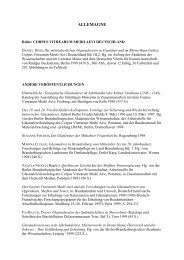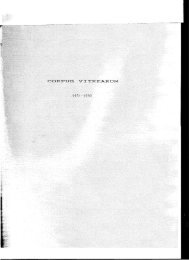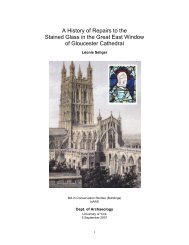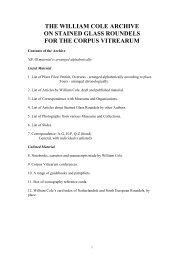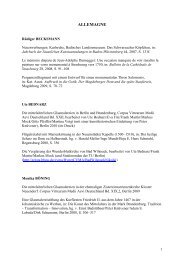BristolConference - Corpus Vitrearum Medii Aevi
BristolConference - Corpus Vitrearum Medii Aevi
BristolConference - Corpus Vitrearum Medii Aevi
Create successful ePaper yourself
Turn your PDF publications into a flip-book with our unique Google optimized e-Paper software.
The Library<br />
The present furnishings of the library were<br />
added to an earlier library building, in the west<br />
range, in the early seventeenth century. The<br />
remains of glass in this west range may be the<br />
earliest surviving English library glazing,<br />
although their original setting remains to be<br />
established for certain. Reading desks were<br />
probably set between the windows originally,<br />
as elsewhere, and the single fully glazed lancets<br />
were designed to allow in the maximum<br />
amount of light. Each now centres a boss<br />
showing the agnus dei against a quarry ground<br />
with ornamental borders. This glass dates<br />
certainly from the late 14thor early lst h century.<br />
In the windows of the later south range have<br />
been set many fragments from elsewhere,<br />
including tracery lights and blackletter<br />
inscriptions, some of which imply scenes from<br />
the life of the patriarch Joseph, a subject<br />
recorded elsewhere in England in the later<br />
middle ages (Durham Cathedral).<br />
Bibliography<br />
H. W. Carrod, Ancient Painted Glass in Merton<br />
College, Oxford, London, 1931<br />
P. Newton, 'Stained Glass at Oxford, Merton<br />
College', Buildings of England, Oxfordshire, ed. J.<br />
Sherwood and N. Pevsner, Harrnondsworth, 1974,<br />
pp. 81-84<br />
Age of Chivalry, Art in Plantagenet England,<br />
1200-1400, exh. cat., Royal Academy of Arts,<br />
London, 1987, cat. no. 738<br />
R. Marks, Stained Glass in England during the Middle<br />
Ages, London, 1993, pp. 16,99,148, 150,154,178<br />
Tim Ayers<br />
Oxford, New College<br />
The dual foundation of a grammar school<br />
(Winchester College, 1382) and a university<br />
college (New College, 1379) by William of<br />
Wykeham, Bishop of Winchester and<br />
Chancellor of England, was unprecedented.<br />
Built to honour the names of Christ and the<br />
Virgin Mary, and to commemorate Wykeham<br />
himself, the colleges were also specifically<br />
intended to benefit the Church by bolstering the<br />
number of ordinands. The majority of New<br />
College's 70 scholars (a number equalling the<br />
total number of fellows in Oxford's six existing<br />
colleges) were drawn from Winchester College,<br />
and directed to study theology in order to<br />
prepare themselves for the parochial ministry.<br />
The concept of providing for both Latin<br />
teaching and university studies was not entirely<br />
new, but Wykeham, one of the greatest of<br />
England's late medieval patrons, was the first to<br />
give it formal and assured continuity by the<br />
generous endowment of two linked colleges.<br />
Wykeham had been acquiring land for his<br />
college in Oxford in a piecemeal fashion since<br />
1369, but it was not until 1380 that the<br />
foundation stone was laid. Building accounts for<br />
the early 1380sdo not survive, but it is likely that<br />
the main quadrangle was substantially complete<br />
by 1386, when the Warden and scholars took<br />
possession. There is evidence, however, that<br />
parts of the northern range (including, perhaps,<br />
elements of the chapel) were not completed until<br />
early in the 15thcentury.<br />
Wykeham, whose career was effectively<br />
launched by his successful tenure as surveyor<br />
of Edward Ill's buildings works at Windsor<br />
(1356-61),brought together a team of the finest<br />
craftsmen to carry out his work at Oxford,<br />
Winchester and his episcopal palace at<br />
Highclere. The master mason at New College<br />
was William Wynford, architect of Winchester<br />
College and of the nave of Winchester<br />
Cathedral.<br />
The college, the first substantial building in<br />
Oxford to be built entirely in dressed stone and<br />
probably the largest erected in the city since the<br />
12thcentury, was of a scale unprecedented in<br />
university architecture. Its integrated<br />
composition - quadrangular plan, hall and<br />
chapel aligned together on the north side (a<br />
feature probably derived from Windsor Castle),<br />
and cloister to the west - was to have a<br />
profound influence on subsequent collegiate<br />
architecture in Oxford.<br />
35



